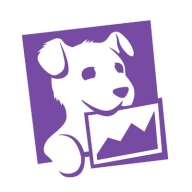

Datadog and Cribl are key players in the observability and data management markets. Datadog appears to have an edge with its extensive monitoring solutions, while Cribl provides significant value in data routing and transformation, which is crucial for handling large-scale data ingestion.
Features: Datadog offers seamless integration into microservices environments with features like APM, RUM, and comprehensive synthetics monitoring. It supports performance monitoring, observability, and debugging. Cribl focuses on data transformation and routing, providing middleware solutions that enhance data flow efficiency between logging systems, proving vital for organizations processing large data volumes.
Room for Improvement: Datadog users indicate a need for improvements in pricing clarity, UI customization, and documentation consistency, along with better debugging and cost control options. Cribl could enhance its real-time storage capabilities, integrations, and administrative functions, with users desiring additional vendor-specific packs and better documentation.
Ease of Deployment and Customer Service: Datadog is predominantly utilized in public and hybrid cloud environments with positive remarks on customer service, although complex issues may experience slower resolutions. Cribl, effective in on-premises and hybrid clouds, is noted for its responsive support, ensuring user satisfaction.
Pricing and ROI: Datadog's pricing model often poses challenges due to its complexity, with a usage-based billing system that can result in unexpected costs; however, it delivers ROI through enhanced operational insights and reduced incident response times. Cribl offers a cost-effective alternative to rivals like Splunk, particularly for large-scale data management, providing substantial savings and value.
The community, including the engineering and sales teams, is available on Slack and is very supportive.
Perhaps more flexibility in terms of metrics would be helpful.
The documentation is adequate, but team members coming into a project could benefit from more guided, interactive tutorials, ideally leveraging real-world data.
There should be a clearer view of the expenses.
The setup cost for Datadog is more than $100.
The community on Slack is excellent for solving questions and getting ideas.
Our architecture is written in several languages, and one area where Datadog particularly shines is in providing first-class support for a multitude of programming languages.
The technology itself is generally very useful.


Cribl optimizes log collection, data processing, and migration to Splunk Cloud, ensuring efficient data ingestion and management for improved operational efficiency.
Cribl offers seamless log collection directly from cloud sources, allowing users to visually extract necessary data and replay specific events for in-depth analysis. It provides robust management of events, parsing, and enrichment of data, along with effective log size reduction. Cribl is particularly beneficial for migrating enterprise logs, optimizing usage, and reducing costs while streamlining the transition between different log management tools.
What are Cribl's most important features?
What benefits and ROI should users look for?
Cribl is widely implemented in industries requiring extensive data management, such as technology and finance. Users leverage Cribl to handle log collection, processing, and migration efficiently, ensuring smooth operation and effective data analysis. It aids in managing temporary data storage during downtimes and better handling historical data, preventing data loss and allowing extended periods for viewing statistics and monitoring trends.
Datadog is a comprehensive cloud monitoring platform designed to track performance, availability, and log aggregation for cloud resources like AWS, ECS, and Kubernetes. It offers robust tools for creating dashboards, observing user behavior, alerting, telemetry, security monitoring, and synthetic testing.
Datadog supports full observability across cloud providers and environments, enabling troubleshooting, error detection, and performance analysis to maintain system reliability. It offers detailed visualization of servers, integrates seamlessly with cloud providers like AWS, and provides powerful out-of-the-box dashboards and log analytics. Despite its strengths, users often note the need for better integration with other solutions and improved application-level insights. Common challenges include a complex pricing model, setup difficulties, and navigation issues. Users frequently mention the need for clearer documentation, faster loading times, enhanced error traceability, and better log management.
What are the key features of Datadog?
What benefits and ROI should users look for in reviews?
Datadog is implemented across different industries, from tech companies monitoring cloud applications to finance sectors ensuring transactional systems' performance. E-commerce platforms use Datadog to track and visualize user behavior and system health, while healthcare organizations utilize it for maintaining secure, compliant environments. Every implementation assists teams in customizing monitoring solutions specific to their industry's requirements.
We monitor all Application Performance Monitoring (APM) and Observability reviews to prevent fraudulent reviews and keep review quality high. We do not post reviews by company employees or direct competitors. We validate each review for authenticity via cross-reference with LinkedIn, and personal follow-up with the reviewer when necessary.